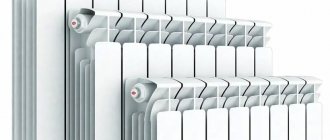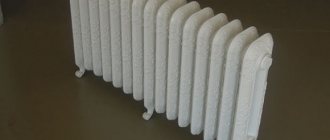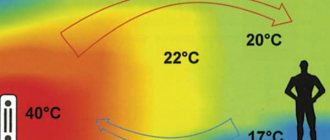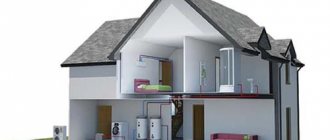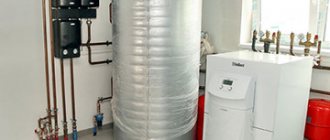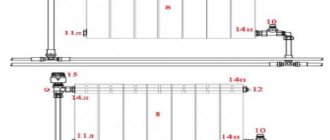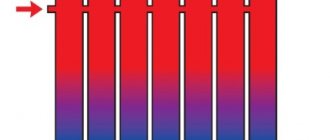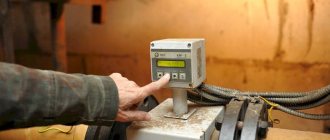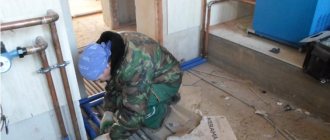Online calculator
Note!
Today, the capabilities of the Internet make it possible to use a computer to calculate the power of heating radiators, taking into account all innovative construction technologies. Calculation of heating radiators
The online calculation formula is similar to the standard one, but is slightly modified to take into account adjustment factors. They are installed:
- On plastic windows that reduce heat loss.
- For external walls - the more there are, the higher the coefficient.
- To the height of the room. If it is more than 2.5 meters, then the coefficient increases.
The basic online calculation takes as a basis the average values for each type of heating battery, the center distance of which is 500 mm. For heat transfer, the following data are accepted into the standard calculation:
- For cast iron radiators - 145 W.
- For bimetallic - 185 W.
- For aluminum - 190 W.
To carry out the calculation, you need to enter all the requested data into the computer database:
- Area and height of the room.
- Number of windows and external walls.
- Type of room and selected radiator.
- Condition and material of the walls.
- Minimum temperature outside.
After filling out the fields of the online form, you only need to click the “Run calculation” option, and after a few seconds the computer will display the result. It's very simple and convenient. An online calculator can be found on the radiator manufacturer's website.
Calculation of aluminum radiator sections per square meter
As a rule, manufacturers pre-calculate the power standards for aluminum batteries, which depend on parameters such as ceiling height and room area. It is believed that heating 1 m2 of a room with a ceiling up to 3 m in height will require a thermal power of 100 W.
These figures are approximate, since the calculation of aluminum heating radiators by area in this case does not provide for possible heat loss in the room or higher or lower ceilings. These are generally accepted building standards that manufacturers indicate in the technical data sheets of their products.
Except them:
The parameter of the thermal power of one radiator fin is of considerable importance. For an aluminum heater it is 180-190 W.
The temperature of the media must also be taken into account
It can be found out from the heating management office if the heating is centralized, or it can be measured independently in an autonomous system. For aluminum batteries the figure is 100-130 degrees. Dividing the temperature by the thermal power of the radiator, it turns out that 0.55 sections are required to heat 1 m2.
In the event that the ceiling height has “outgrown” classical standards, then it is necessary to apply a special coefficient: if the ceiling is 3 m, then the parameters are multiplied by 1.05; at a height of 3.5 m it is 1.1; with an indicator of 4 m - this is 1.15; wall height 4.5 m – coefficient is 1.2.
You can use the table that manufacturers provide for their products.
How many sections of aluminum radiator are needed?
The number of sections of an aluminum radiator is calculated according to a form suitable for heaters of any type:
Q = S x100 x k/P
In this case:
- S – area of the room where the battery installation is required;
- k – adjustment factor of 100 W/m2 depending on the ceiling height;
- P – power of one radiator element.
When calculating the number of sections of aluminum heating radiators, it turns out that in a room with an area of 20 m2 with a ceiling height of 2.7 m, an aluminum radiator with a power of one section of 0.138 kW will require 14 sections.
Q = 20 x 100 / 0.138 = 14.49
In this example, the coefficient is not applied, since the ceiling height is less than 3 m
But even such sections of aluminum heating radiators will not be correct, since the possible heat loss of the room is not taken into account. It should be borne in mind that depending on how many windows there are in the room, whether it is corner and whether it has a balcony: all this indicates the number of sources of heat loss
When calculating aluminum radiators by room area, the formula should take into account the percentage of heat loss depending on where they will be installed:
- if they are fixed under the window sill, then the losses will be up to 4%;
- installation in a niche instantly increases this figure to 7%;
- if an aluminum radiator is covered with a screen on one side for beauty, then the losses will amount to 7-8%;
- completely covered with a screen, it will lose up to 25%, which makes it, in principle, unprofitable.
These are not all the indicators that should be taken into account when installing aluminum batteries.
Self-production of heating registers
Making a heating device yourself is not very difficult; you only need some welding skills and a welding machine.
It is easier to make a sectional device - for the coil you will have to bend pipes of a fairly large diameter, and it is difficult to accurately bend at home.
Before starting work, you need to prepare tools and materials:
- Welding machine.
- Drill.
- Bulgarian.
- Hammer.
- Roulette.
- Marker.
- Clamps.
Blanks from pipes, jumper pipes of a smaller cross-section (with an internal cross-section of 20-25 mm), and rods of the same length are marked and cut with a grinder for welding between pipes for structural rigidity. The plugs are cut 3-5 mm smaller than the internal diameter of the pipe - this will allow them to be carefully “sunk” into the end of the pipe. The thickness of the plugs is 3-3.5 mm.
Holes are marked for jumper pipes, pipes for connecting the register to Mayevsky's systems and taps. Holes are drilled with a drill.
Before welding the register, it is necessary to place all the workpieces on a strictly horizontal surface - a metal workbench or a platform in the yard.
Sequence of assembly work
Work on assembling the register is carried out in the following order:
- When placing the workpieces horizontally, jumpers and rods (if necessary) are fixed and secured in several places by welding. On one side of the device, a jumper tube is welded between the pipes, and on the other, a rod connecting the two threads.
- Then the structure is installed vertically, jumpers and rods are welded.
- First, weld with a thin seam, then check all angles and dimensions, and weld with a thick working seam.
- The internal cavity of the pipes is cleaned of dust and slag introduced during the welding process.
- The plug plates are attached to the ends of the pipes.
- The plugs are welded - in the same two seams as the jumpers.
- Welding seams are cleaned with a grinder.
- Threaded pipes are welded to the side holes.
- The Mayevsky crane is being installed.
- Before connecting, the device must be tested. For a system in a multi-storey building, it must withstand 1.6 MPa or 16 atmospheres; for a private house, 5 atmospheres is enough - in small systems there is no high pressure.
Installation of a register in a heating system
The installation of the register is not fundamentally different from the installation of a radiator - taps with union nuts are installed at the inlet and outlet, and a Mayevsky tap is installed on the pipe at the top.
In a system with registers, the coolant temperature drops faster, so the use of a single-pipe heating system is undesirable.
Process video
The register manufacturing process can be seen in detail in the video:
Adjusting results
In order to obtain a more accurate calculation, you need to take into account as many factors as possible that reduce or increase heat loss. This is what the walls are made of and how well they are insulated, how large the windows are and what kind of glazing they have, how many walls in the room face the street, etc. To do this, there are coefficients by which you need to multiply the found values of heat loss in the room.
The number of radiators depends on the amount of heat loss
Windows account for 15% to 35% of heat loss. The specific figure depends on the size of the window and how well it is insulated. Therefore, there are two corresponding coefficients:
- ratio of window area to floor area: 10% - 0.8
- 20% — 0,9
- 30% — 1,0
- 40% — 1,1
- 50% — 1,2
- three-chamber double-glazed window or argon in a two-chamber double-glazed window - 0.85
Walls and roof
To account for losses, the material of the walls, the degree of thermal insulation, and the number of walls facing the street are important. Here are the coefficients for these factors.
- brick walls two bricks thick are considered the norm - 1.0
- insufficient (absent) - 1.27
- good - 0.8
Presence of external walls:
- interior space - no losses, coefficient 1.0
- one - 1.1
- two - 1.2
- three - 1.3
The amount of heat loss is influenced by whether the room is located on top or not. If there is a habitable heated room on top (the second floor of a house, another apartment, etc.), the reduction factor is 0.7, if there is a heated attic - 0.9. It is generally accepted that an unheated attic does not affect the temperature in any way (coefficient 1.0).
It is necessary to take into account the characteristics of the premises and climate in order to correctly calculate the number of radiator sections
If the calculation was carried out by area, and the ceiling height is non-standard (a height of 2.7 m is taken as the standard), then a proportional increase/decrease using a coefficient is used. It is considered easy. To do this, divide the actual ceiling height in the room by the standard 2.7 m. You get the required coefficient.
Let's do the math for example: let the ceiling height be 3.0m. We get: 3.0m/2.7m=1.1. This means that the number of radiator sections that was calculated by area for a given room must be multiplied by 1.1.
All these norms and coefficients were determined for apartments. To take into account the heat loss of a house through the roof and basement/foundation, you need to increase the result by 50%, that is, the coefficient for a private house is 1.5.
Climatic factors
Adjustments can be made depending on average winter temperatures:
Having made all the required adjustments, you will receive a more accurate number of radiators required to heat the room, taking into account the parameters of the premises. But these are not all the criteria that influence the power of thermal radiation. There are also technical subtleties, which we will discuss below.
Calculation of heating radiators and convectors in Excel.
Initial data:
1.
Write down the type of heating device selected
into combined cells C3D3E3: Radiator MS-140-108
2.
Number of devices (sections) connected in series
N
in pcs. enter
to cell D4: 10
We take the following 5 parameters from
the technical characteristics of the device manufacturer.
3.
the nominal heat flux of the device (section)
Qn
in W
to cell D5: 185
4.
the nominal temperature difference of the device (section)
dtн
in °C
to cell D6: 70
5.
the nominal water flow through the device (section)
Gn
in kg/hour
to cell D7: 360
6.
We write down the indicator of nonlinearity of heat transfer from temperature
n
to cell D8: 0,30
7.
We write down the nonlinearity index of heat transfer from flow rate
p
to cell D9: 0,02
We set the next 3 parameters based on the expected reality of subsequent operation . They depend on the source of heat supply and the type of room.
8.
the
“supply” water temperature
tp in °C
to cell D10: 85
9.
the return water temperature
tо in
°C
to cell D11: 60
10.
Enter the air temperature in the room
t in
to cell D12: 18
Calculation results:
11.
the nominal heat flow
N
devices (sections)
ΣQ n
in kW
in cell D14: =D4*D5/1000 =1,850
ΣQ n = N * Q n /1000
12.
The temperature difference
dt
in °C is determined
in cell D15: =(D10+D11)/2-D12 =54,5
dt=( t p + t o )/2-
t in
13.
The estimated optimal water consumption
G
in kg/hour is calculated
in cell D16: =((0.86*D14*1000*((D15/D6)^(D8+1))*(1/D7)^D9)/(D10-D11))^(1/(1 -D9)) =44
G =((0.86* ΣQ n *1000*(( dt dt n )( n +1) )*(1/ G n ) p )/( t p -
t o )(1/(1- p ) )
14.
the estimated heat transfer of N heating devices (sections)
Q
in kW
in cell D17: =D14*((D15/D6)^(D8+1))*(D16/D7)^D9 =1,281
Q = ΣQ n *(( dt dt n )( n +1) )*( G G n ) p
and do a check
in cell D18: =D16/0.86*(D10-D11)/1000 =1,281
Q = G /0.86* ( t p -
t o )/1000
15.
The share of real heat transfer
of N
devices from the nominal heat flow
∆
in % is determined
in cell D19: =D17/D14*100 =69
∆= Q ΣQ n *100
At this point, the Excel calculation of the heating radiator MS 140-108, consisting of 10 sections, is completed.
Let's perform a similar calculation in Excel for the KSK 20-2,083PS convector.
Production of heating registers
Five basic types of heat exchanger configurations.
If you want to make such a heat exchanger with your own hands, you will need to calculate the heating register. To do this, it is most convenient to use the following formula:
Q = Pichdнхlхkhkh(tg - to)x(1 - ηiz) , where:
- Pi = 3.14;
- dн is the value of the outer diameter of the pipeline, m;
- l is the length of the section or section, m;
- to is the air temperature in the room where the device is planned to be installed;
- tg is the temperature of the coolant (water) in the pipeline;
- k is the heat transfer coefficient equal to 11.63 W/m²*°C;
- ηiz is the coefficient of heat transfer (heat retention) by insulation, for an insulated device ηis = 0.6÷0.8, for a conventional device the coefficient is taken equal to zero.
So, for a pipe with a length of, say, 5 meters and a diameter of 159 mm, at a coolant temperature of 80 degrees and a room temperature of 23 degrees, we get the following value:
Q = 3.14x0.159x5x11.63x(80 – 23)x(1 – 0) = 1654.8 W.
This is the power of the heating registers applicable to a horizontal pipe laid in one row. For several rows, a reduction factor of 0.9 is applied for each additional row.
Advice! Heating register calculations can also be done using online calculators, but be careful: they often give the wrong answer. Therefore, you must first check the calculator with the formula, and only then use it.
Installation of heating registers should be carried out in accordance with GOST. To work, you will need welding, since the mount must be rigid and withstand the significant weight of the device and water (also find out about the features of installing heating radiators).
How to calculate
Different climatic zones of our country for heating apartments according to standard building codes and regulations have their own values. In the middle zone at the latitude of Moscow or the Moscow region, heating 1 square meter of living space with a ceiling height of up to 3 meters will require 100 watts of thermal power.
For example, to heat a room of 20 square meters, you will need to spend 20 × 100 = 2000 Watts of thermal energy. If one section of a cast iron battery has a heat output of 160 watts, then the calculation of the number of sections will look like this: 2000:160=12.5. This means, rounding up, 12 sections or two batteries of 6 sections each.
Similar calculations can be made for other types of radiators:
- aluminum;
- bimetallic;
- steel.
Disadvantages of simplified calculation
Calculations are carried out on the basis of formulas.
A simplified calculation assumes ideal sealing conditions for our apartments. However, here it is necessary to take into account the specific features of the winter period, namely:
- Up to 50% of the heat entering the apartment can evaporate through window openings. Therefore, installing modern double-glazed windows will significantly reduce heat loss.
- Corner apartments require more heat for heating, since their two walls face the street.
- During the heating season, the central heating system does not always work like clockwork. Sometimes fluctuations in coolant temperature, extreme frosts, unplanned gusts or other technical force majeure situations occur. Batteries installed according to calculations will not provide their full heat transfer power. Therefore, when installing radiators, their number should be 20% higher than calculated.
Manufacturing and installation
Making registers is quite possible with your own hands. In this case, it is necessary to calculate the optimal movement of the coolant and install jumpers between the pipes accordingly.
Preparatory stage
The calculation of the required register power is made according to a constant - 1 linear meter of a smooth or profile pipe with a cross-sectional diameter of 60 mm will heat 1 m2 of room with a ceiling height of up to 3 m. In this case, it is necessary to take into account the thickness of the walls, the presence of windows and doors and their number, and the thermal insulation of the floors. After calculating the power, a drawing of the product is made.
Please note that significant cost savings can only be achieved by making heating registers yourself.
Equipment made from corrugated pipes
At the first stage, the profile pipe is cut into pieces of a given length. Marks are made in the resulting blanks for the holes of the pipes. After this, jumpers are welded into horizontally laid pipes, and the ends are closed with plugs.
Nozzles for supply and return of coolant are welded to the upper and lower sections. On the other side of the upper pipe, a threaded pipe is welded to connect the air vent valve.
Products made from round pipes
The technical and operational characteristics of devices made from smooth pipes are quite mediocre compared to traditional radiators that have a radiating screen. To increase heat transfer rates, steel plates are welded onto the pipes with your own hands, increasing the area of thermal radiation.
This must be taken into account when installing heating devices
The value obtained using the calculator is indicative
In addition, you need to take into account that the characteristics declared by the manufacturer are not always confirmed in practice. This means that it is better to accept 10% more sections for installation, rounding up to the whole part
If you are worried that the room will be too hot in winter, then install a valve on the radiator that regulates the amount of circulating coolant. It will also help save time if it is necessary to replace one of the sections.
Distances must be strictly maintained within the established limits:
- The width of the assembled window sections must be at least 70%. This means that it is better to install more sections with lower thermal power.
- The distance from the top of the device to the window sill should be within 100-120 mm. Otherwise, it will be much more difficult to predict the magnitude of the heat flow.
- In order not to heat the street, radiators must be at least 50 mm away from the wall.
- A distance of 100 mm must be maintained between the floor plane and the bottom point of the heating device.
We hope that this material will be useful when carrying out repair work or installing a new water heating system.
Brick barbecues do not have to be huge monsters that cost a lot of money to build. They can be compact, neat, and easily fit into the design of any area.
Most importantly, they can be relatively inexpensive. In this article we provide examples of brick barbecues that will easily decorate your summer kitchen
No one is immune from this. The conveniences that we have long been accustomed to when living in urban environments sooner or later show their downside. Does the water not drain away, threateningly filling more than half the volume of the toilet bowl? What to do if it gets clogged? You can call a plumber, or you can solve the problem yourself. Fortunately, there are enough options to solve the problem.
Are you preparing to build an extension to your home? Have you decided to add a second floor? Perhaps the old foundation of the house scares you with an abundance of cracks and uncharacteristic distortion? All this indicates the need to strengthen the foundation. We have tried to summarize data that will be useful in resolving this issue.
How to calculate radiator sections by room volume
This calculation takes into account not only the area, but also the height of the ceilings, because all the air in the room needs to be heated. So this approach is justified. And in this case the technique is similar. We determine the volume of the room, and then, according to the standards, we find out how much heat is needed to heat it:
- in a panel house, heating a cubic meter of air requires 41 W;
- in a brick house per m 3 - 34 W.
You need to heat the entire volume of air in the room, so it is more correct to calculate the number of radiators by volume
Let's calculate everything for the same room with an area of 16m2 and compare the results. Let the ceiling height be 2.7m. Volume: 16*2.7=43.2m3.
Next we will calculate for options in a panel and brick house:
- In a panel house. The heat required for heating is 43.2m 3 *41V=1771.2W. If we take all the same sections with a power of 170 W, we get: 1771 W/170 W = 10,418 pcs (11 pcs).
- In a brick house. The heat needed is 43.2m 3 *34W=1468.8W. We count the radiators: 1468.8W/170W=8.64pcs (9pcs).
As you can see, the difference is quite large: 11 pieces and 9 pieces. Moreover, when calculating by area, we got the average value (if rounded in the same direction) - 10 pcs.
Calculation method for room volume
The calculation method taking into account the volume of the ceiling will be more accurate: it takes into account the height of the ceilings in the apartment and the material from which the external walls are made. The sequence of calculations will be as follows:
- The volume of the room is determined by multiplying the area of the room by the height of the ceiling. For a room of 15 square meters. m. and a ceiling height of 2.7 m, it will be equal to 40.5 cubic meters.
- Depending on the material of the walls, different amounts of energy are spent on heating one cubic meter of air. According to SNiP standards, for an apartment in a brick house this figure is 34 W, for a panel house - 41 W. This means that the resulting volume must be multiplied by 34 or 41 W. Then for a brick building, heating a room of 15 square meters will require 1377 W (40.5 * 34), for a panel building - 1660.5 W (40.5 * 41).
USEFUL INFORMATION: Panoramic window: in an apartment and a private house, pros and cons
Adjustment depending on heating system mode
Manufacturers indicate the maximum power of radiators in the passport data: in high-temperature mode of use - the coolant temperature in the supply is 90 o C, in the return - 70 o C (indicated by 90/70) in the room there should be 20 o C. But in this mode, modern systems The heating works very rarely. Typically, a medium power mode of 75/65/20 or even a low temperature mode with parameters of 55/45/20 is used. It is clear that the calculation needs to be adjusted.
To take into account the operating mode of the system, it is necessary to determine the temperature pressure of the system. Temperature pressure is the difference between the temperature of the air and the heating devices. In this case, the temperature of the heating devices is considered as the arithmetic average between the supply and return values.
It is necessary to take into account the characteristics of the premises and climate in order to correctly calculate the number of radiator sections
To make it clearer, we will calculate cast iron heating radiators for two modes: high temperature and low temperature, standard size sections (50cm). The room is the same: 16m2. One cast iron section in high temperature mode 90/70/20 heats 1.5m2. Therefore, we need 16m2/1.5m2 = 10.6 pieces. Round up - 11 pcs. The system plans to use a low temperature mode of 55/45/20. Now let’s find the temperature difference for each of the systems:
- high temperature 90/70/20- (90+70)/2-20=60 o C;
- low temperature 55/45/20 - (55+45)/2-20=30 o C.
That is, if a low-temperature operating mode is used, twice as many sections will be needed to provide the room with heat. For our example, a room of 16 m2 requires 22 sections of cast iron radiators. The battery turns out to be big. This, by the way, is one of the reasons why this type of heating device is not recommended for use in networks with low temperatures.
With this calculation, you can also take into account the desired air temperature. If you want the room to be not 20 o C but, for example, 25 o C, simply calculate the thermal pressure for this case and find the desired coefficient
Let's do the calculation for the same cast iron radiators: the parameters will be 90/70/25. We calculate the temperature difference for this case (90+70)/2-25=55 o C. Now we find the ratio 60 o C/55 o C=1.1. To ensure a temperature of 25 o C you need 11 pcs * 1.1 = 12.1 pcs.
How to increase the heat transfer of a heating pipe with your own hands
Calculation of the heat transfer of a pipe is required when designing heating, and is needed to understand how much heat will be required to warm up the premises and how long it will take. If installation is not carried out according to standard designs, then such a calculation is necessary.
What systems require calculations?
The heat transfer coefficient is calculated for heated floors. This system is made less and less often from steel pipes, but if products made from this material are chosen as coolants, then calculations must be made. The coil is another system, when installing which it is necessary to take into account the heat transfer coefficient.
Radiator made of steel pipes
Registers are presented in the form of thick pipes connected by jumpers. The average heat output of 1 meter of this design is 550 W. The diameter ranges from 32 to 219 mm. The structure is welded so that there is no mutual heating of the elements. Then heat transfer increases. If you assemble the registers correctly, you can get a good room heating device - reliable and durable.
How to optimize the heat transfer of a steel pipe?
During the design process, specialists are faced with the question of how to reduce or increase the heat transfer of 1 m of steel pipe. To increase, you need to change the infrared radiation upward. This is done with paint. Red color increases heat transfer. It is better if the paint is matte.
Another approach is to install fins. It is mounted outside. This will increase the heat transfer area.
In what cases does it need to be reduced? The need arises when optimizing a pipeline section located outside a residential area. Then experts recommend insulating the area - isolating it from the external environment. This is done using polystyrene foam, special shells that are made from special foamed polyethylene. Mineral wool is also often used.
We make a calculation
The formula by which heat transfer is calculated is as follows:
- K – thermal conductivity coefficient of steel;
- Q – heat transfer coefficient, W;
- F is the area of the pipe section for which the calculation is being made, m 2 dT is the value of the temperature pressure (the sum of the primary and final temperatures taking into account room temperature), ° C.
The thermal conductivity coefficient K is selected taking into account the area of the product. Its size also depends on the number of threads laid in the premises. On average, the coefficient is in the range of 8-12.5.
dT is also called temperature difference. To calculate the parameter, you need to add the temperature that was at the outlet of the boiler with the temperature that was recorded at the entrance to the boiler. The resulting value is multiplied by 0.5 (or divided by 2). The room temperature is subtracted from this value.
If the steel pipe is insulated, then the resulting value is multiplied by the efficiency of the insulating material. It reflects the percentage of heat that was given off during the passage of the coolant.
We calculate the return for 1 m of product
It is easy to calculate the heat transfer of 1 m of pipe made of steel. We have a formula, all we have to do is substitute the values.
Q = 0.047*10*60 = 28 W.
- K = 0.047, heat transfer coefficient;
- F = 10 m2. pipe area;
- dT = 60° C, temperature difference.
It's worth remembering
Do you want to make a heating system correctly? You should not select pipes by eye. Heat transfer calculations will help optimize construction costs. In this case, you can get a good heating system that will last for many years.
Increased heat transfer from the heating main
While studying ways to effectively heat various types of rooms, owners are wondering how to increase the heat transfer of a heating pipe. The main thing in this is the ratio of the volume of the pipe to its entire surface area.
The obtained indicators will help you make all calculations correctly and avoid mistakes. In addition, this issue should be raised during construction work, since it is more difficult to resolve this issue in a finished facility.
Calculation of steel panel heating radiators. Varieties
Types of steel heating radiators
Let's consider panel-type steel radiators, which vary in size and power level. Devices can consist of one, two or three panels. Another important design element is fins (corrugated metal plates). To achieve certain thermal output values, several combinations of panels and fins are used in the design of the devices. Before choosing the most suitable device for high-quality room heating, you need to familiarize yourself with each type.
Main types of steel radiators
Steel panel batteries are available in the following types:
Type 10. Here the device is equipped with only one panel. Such radiators are light in weight and have the lowest power.
Steel heating radiators type 10
Type 11. Consists of one panel and a fin plate. The batteries are slightly heavier and larger than the previous type, and have higher thermal power parameters.
Steel panel radiator type 11
- Type 21. The radiator has two panels, between which there is a corrugated metal plate.
- Type 22. The battery consists of two panels, as well as two fin plates. The device is similar in size to type 21 radiators, however, compared to them, they have greater thermal power.
Steel panel radiator type 22
Type 33. The design consists of three panels. This class is the most powerful in terms of thermal output and the largest in size. In its design, 3 fin plates are attached to three panels (hence the type number - 33).
Steel panel radiator type 33
Types of heating registers
There are two main forms in which heating registers are made.
Despite the apparent diversity, all models can be divided into two main types: sectional and S-shaped (coil).
Sectional
The photo shows a device consisting of four sections.
Sectional devices consist of one or more pipes closed with plugs. Water flows into the top pipe through a pipe, then at the other end it flows into the next pipe, etc.
This heat exchanger is made from a smooth steel pipe with a diameter of 25 to 400 mm. The most popular diameters are 76, 89, 108 and 159 mm. The inlet and outlet pipes can be threaded or flanged; it is also possible to manufacture them for welding.
In addition, the device has a threaded fitting to which an air vent is connected. The maximum operating coolant pressure allowed in such devices is 10 kgf/cm² or 1 MPa.
The plugs can be flat or elliptical (the latter can be ordered separately). The transition from one section to the next is done as close to the edge as possible, since the amount of heat transferred to the medium depends on this (
Purpose of calculations
Regulatory documentation on heating (SNiP 2.04.05-91, SNiP 3.05-01-85), construction climatology (SP 131.13330.2012) and thermal protection of buildings (SNiP 23-02-2003) requires the heating equipment of a residential building to fulfill the following conditions:
- Ensuring full compensation of heat losses of the home in cold weather;
- Maintaining nominal temperatures in the premises of a private home or public building, regulated by sanitary and construction standards. In particular, a bathroom requires a temperature within 25 degrees C, while a living room requires a temperature significantly lower, only 18 degrees C.
The concept of warm comfort should be interpreted not only as a positive temperature of an arbitrary value, but also as a maximum permissible value. There is no point in installing radiators with two dozen sections to heat a small-sized children's bedroom, if for the sake of fresh air (overly heated radiators “burn” the oxygen around them) you have to open the window.
Heating battery assembled with an excessive number of sections
Using a heating system calculation calculator, the thermal power of a radiator is determined for efficient heating of a living space or utility room within a specified temperature range, after which the radiator format is adjusted.
Heating register power calculation
What parts does the heating register consist of?
Calculating the power of the heating register consists of selecting the required dimensions of the heat exchanger. This directly affects the amount of coolant in it and the heat exchange area. The larger the register, the larger the room it can heat.
It turns out that you need to determine the diameter of the pipes in such a way that the heat transfer from the heating registers has a sufficient level to heat a room of a certain area. This is if you have the opportunity to choose, but if the register is made from what is available, then you may have to change the design a little.
Each region has its own standards for the amount of energy to heat one meter of space. To calculate registers from smooth pipes for heating, you can take the average value of 100 W. If you are worried that there won’t be enough, then just make a 50% reserve. Now we adjust our register to these requirements. For clarity, let’s take as an example a heating register made of three pipes, each two meters in size. Algorithm of actions:
- determine the area of the room;
- We calculate how much power is needed to heat it;
- We substitute the value into the formula for determining the diameter.
Before calculating the number of registers for heating, you need to know how much thermal power will be required in a given case. Then, based on this, decide how to distribute it.
Let's say that we have a room of 50 square meters. It turns out that we will need 500 W of thermal power so that the air temperature is within the limits established by regulatory documents. The formula for calculating the diameter has the following values:
- P – 3.14;
- register length;
- coefficient of thermal conductivity of metal, for steel 11.63;
- difference between supply and return temperatures.
As a standard for calculating the difference in supply and return temperatures, take the value of 80 and 20 degrees, respectively. If you know that the temperature in your circuit will not exceed 65 degrees, then you substitute your value. We will continue the calculation based on average values, that is, the temperature difference is 60 degrees.
Pipe diameter = 500 / (3.14 * 6 (three pipes of 2 meters each) * 11.63 * 60) = 0.038
We got the value in meters, which is 38 mm. It turns out that in order to heat a room of 50 square meters with a register of three horizontal sections of two meters, you need to use pipes with an internal diameter of at least 38 mm. If it turns out that you need to weld a register from existing pipes, then you need to calculate the total length of the segments. To do this, you can calculate this value from an existing formula.
Length of sections = 500 / (3.14*11.63*60*section of our pipes in meters)
For the manufacture of registers, pipes with a diameter of 32 mm are used, let’s say they are in stock. Substituting the value into the calculation, we can calculate that to heat such a room you will need 7.1 meters. This value can be divided into several segments. It turns out that calculating the number of heating registers comes down to finding out the total length of pipes with a given diameter, and then dividing it into convenient segments.
You can make heating in the bathhouse with your own hands. Do you want to learn?
Perhaps you are interested in heating a garden house with your own hands, then click here.
Calculators for calculating heating register parameters
Traditional heat exchange devices installed in residential premises are heating radiators. However, you can often come across a picture where the owners, apparently for reasons of economy, prefer to make do with homemade registers, that is, cascade welded sections of large diameter pipes. This approach is usually widely used in utility or utility buildings and premises, but with careful assembly and painting, registers can easily fit into the interior of a living room.
Calculators for calculating heating register parameters
However, savings with this approach are far from obvious: in fact, in terms of heat transfer capabilities, any register usually loses to much more compact and neat-looking radiators. In any case, there is no need to expect any miracles from its installation. And if so, then you should plan the installation of such heating devices only after calculations and a comparative analysis of cost and efficiency. And calculators for calculating heating register parameters will help us in this matter.
The following calculation algorithm is proposed:
- First, the first calculator determines the amount of heat loss that requires compensation from the heating system. In a word, the required heating power for a specific room is calculated.
- Having the value of the required power, on the second calculator you can quickly and accurately “design” a heating register with the required heat transfer - that is, determine its length, the number of sections and the diameter (section) used for the manufacture of pipes.
Prices for copper pipes
copper pipes
Below, under the calculators themselves, the necessary explanations for carrying out the calculations will be given.
Calculators for calculating heating register parameters
Calculator for calculating the required thermal power for heating a room
Go to calculations
Calculator for selecting optimal heating register parameters
Go to calculations
Explanations for calculations
According to the calculation of thermal power
The algorithm is based on taking into account those specific features of the room that affect the amount of heat loss from it:
- The area of the room and the height of the ceiling will determine the approximate volume of the room.
- The next point is the number of walls facing the street. The more external walls, the greater the heat loss through them - an appropriate amendment will be made to the calculation program.
- Specific data - where the external walls face in relation to the cardinal directions and the prevailing winds in winter. It seems that this is a trifle, but for the authenticity of the picture it doesn’t hurt to take it into account. It is clear that the wall on the north side, that is, never seeing the Sun, or almost always facing the frosty wind, will cool down much faster.
- The next point is the minimum temperatures characteristic of the region in the coldest decade of the year. The emphasis is NOT on abnormal frosts, but on the minimum that is normal for your climatic conditions.
- The following input field reflects the degree of thermal insulation of the room and offers to evaluate the degree of insulation of external walls. Only one on which thermal insulation work has been carried out in full on the basis of thermal engineering calculations can be considered fully insulated. In principle, there should not be any uninsulated walls in residential buildings - it could be a garage, barn, etc., and even then a good owner strives to provide at least a minimum level of thermal insulation in such buildings.
- Next, you should evaluate the “neighborhood” of the room vertically, that is, above and below. Heat leaks through ceilings and floors can be quite significant, so it is unwise to ignore this circumstance. You must select the required items from the drop-down lists.
- Next are the windows. You will need to enter their type, quantity and size. Based on these data, the calculation program will make the necessary amendments to the final result.
- And finally, the room may have a door opening onto the street (into an unheated room). If the door is regularly used, then any opening of it is accompanied by the penetration of a large mass of cold air into the room, and this requires a certain “compensation” by increasing the heating power.
The final result will be shown in watts and kilowatts. We write down the value and move on to the next calculator.
By selecting heating register parameters
Yes, exactly by selection, based on the calculation of the required thermal power.
The fact is that in cases where it is planned to manufacture and install a heating register, the owner, as a rule, already has some initial data. For example, he knows for sure that in a room you can allocate 4 meters along the outer wall for installing a register - and no more, but there are no special restrictions on the number of parallel sections. Another example is that the very idea of making a register was prompted by the presence on the farm of pipes of a specific diameter that were unnecessary for other purposes. So that they do not lie around in vain, they are used to make a heating device.
Other initial options are possible - but still the calculator makes it possible to very quickly and accurately “design” the register.
What is indicated in the input fields:
- The temperature regime of the heating system is the average temperature in the supply pipe and in the return pipe. Based on these parameters, taking into account the air temperature in the room (it is assumed, for simplicity, to be stable at +20°C), the value of the so-called thermal pressure required for further calculations is calculated. These temperature data will not need to be changed in further calculations.
- But it’s quite possible to “play” with the dimensional indicators of the register. This means that you can try to change the number of sections, the length of the register, the diameter or cross-section of the pipes from which the device will be made, so that the final value in the calculation is no less than that obtained when working with the first calculator.
This is not at all difficult, and in practice it takes literally a minute or two. But it becomes possible to find several acceptable options, for example, from pipes of different sections - with different numbers of sections. By comparing the cost-effectiveness, the degree of assembly complexity, and the appearance of these options, you can finally decide on the optimal one for your conditions.
Heating registers - pros and cons
You shouldn’t attribute too much “magical” qualities for heating rooms to these devices. Rather, on the contrary, their installation should be resorted to when there are really compelling reasons. More information about this, as well as about calculations and production of heating registers , can be found in a special publication on our portal.
Calculation of heat transfer: main points
During the installation of a heating system, many are interested in calculating registers made of smooth pipes. How to calculate so that there are not too many of them (it will be very hot) or too few (it will be cool)?
For a private house or apartment there is no need to calculate the exact figure, since in this case the specific temperature value is not important. It is important that the temperature is optimal. The simplest calculation: per 2 m2 there should be one section (cast iron or aluminum), per 1.5 m2 - one section (bimetal). If the ceiling is more than 3 meters, one section should be added
If there is a balcony, one or two sections are also added, depending on whether the balcony is insulated or not. A section is added if the room is corner. Since the coolant supply temperature is regulated by the utility service, it is possible to calculate the heat transfer of the register for apartments regardless of the climate. In private homes, this calculation is not suitable due to the fact that the water entering the system is too hot. This causes severe overheating if the building is located in warm regions. In addition, the calculation of the heat transfer of the heating register can be performed using online calculators. To do this, you will need to enter some data, and then the program will calculate the required number of pipes.
Specifications
Technical requirements for heating devices, including tubular radiators, are standardized by GOST 31311-2005. According to this standard, pipes in accordance with GOST 3262, GOST 8734, GOST 10705, GOST 10706 with a wall thickness of at least 1.25 mm must be used for their manufacture. At the same time, heated towel rails are allowed to be made from carbon steel with a wall of at least 3 mm, stainless steel, as well as brass (copper-zinc alloys) in accordance with GOST 15527.
It is also possible to use other materials if the heating devices comply with all provisions of the standard and have the necessary strength characteristics. The design of devices is not standardized and remains at the discretion of the manufacturer, subject to compliance with basic requirements. This gives complete freedom for creativity and allows you to create unique design configurations of tubular radiators, which significantly expands the scope of their application.
The characteristics of heating registers made of smooth pipes depend on the selected material, size and configuration. They are determined using special formulas, tables or manufacturer’s materials.
Let's consider the main parameters of conventional steel registers. They are characterized by the use of large diameter pipes, mainly in the range of 32-219 mm. They can withstand operating pressure up to 100 Pa (10 kgf/m²). The coolant can be a variety of liquids - water, antifreeze, oil - or high-temperature steam.
Having a detailed drawing, a register from smooth steel pipes can be made by any craftsman with welding skills. To do this, just find the source material, a welding machine and an angle grinder. You can also order the register at the factory according to individual drawings.
It is necessary to maintain not only the length, diameter and number of pipes, but also the distance between them. Too close a location significantly reduces the heat transfer of the device due to the mutual influence of the elements. If the distance is made too large, then the height of the device can be enormous and not convenient to install and use. The optimal spacing of the rows of the heating register is considered to be 1.5 radii, but not less than 50 mm.
To obtain the best results, all parameters must be determined on the basis of thermal calculations, based on the required heat transfer and the characteristics of the room. Without proper calculation, even a well-made register may not be able to cope with heating the available area.
How to calculate the number of radiator sections
There are several methods for calculating the number of radiators, but their essence is the same: find out the maximum heat loss of the room, and then calculate the number of heating devices required to compensate for them.
There are different calculation methods. The simplest ones give approximate results. However, they can be used if the premises are standard, or coefficients can be applied that allow one to take into account the existing “non-standard” conditions of each specific room (corner room, access to a balcony, wall-to-wall window, etc.). There is a more complex calculation using formulas. But essentially these are the same coefficients, only collected in one formula.
There is another method. It determines the actual losses. A special device - a thermal imager - determines real heat loss. And based on this data, they calculate how many radiators are needed to compensate for them. Another good thing about this method is that the thermal imager image shows exactly where the heat is lost most actively. This could be a defect in work or building materials, a crack, etc. So at the same time we can improve the situation.
The calculation of radiators depends on the heat loss of the room and the rated thermal power of the sections
Rules for installing heating registers with your own hands
Registers, like most other heating devices, are installed near external walls and under windows. A structure of 4 pipes is usually placed under the windows. Often a single metal conduit is run along a blank exterior wall near the floor.
The devices are quite heavy and must be securely fastened to brackets and supports. It is not advisable to weld the legs to the register.
The distance between the pipes should be equal to one diameter plus 50 mm (the size of the profile pipe plus 50 mm). When pipes are placed close to the register, the efficiency of heat transfer decreases.
Very accurate calculation of heating radiators
Above we gave an example of a very simple calculation of the number of heating radiators per area. It does not take into account many factors, such as the quality of wall insulation, type of glazing, minimum outside temperature and many others. Using simplified calculations, we can make mistakes, resulting in some rooms being cold and others too hot. The temperature can be corrected using shut-off valves, but it is best to foresee everything in advance - at least for the sake of saving materials.
If during the construction of your house you paid decent attention to its insulation, then in the future you will save a lot on heating. How is an accurate calculation of the number of heating radiators in a private house made? We will take into account decreasing and increasing coefficients
First, let's touch on the glazing. If the house has single windows, we use a coefficient of 1.27. For double glazing the coefficient does not apply (in fact it is 1.0). If the house has triple glazed windows, we apply a reduction factor of 0.85
How is an accurate calculation of the number of heating radiators in a private house made? We will take into account decreasing and increasing coefficients. First, let's touch on the glazing. If the house has single windows, we use a coefficient of 1.27. For double glazing the coefficient does not apply (in fact it is 1.0). If the house has triple-glazed windows, we apply a reduction factor of 0.85.
Are the walls in the house laid with two bricks or is insulation provided in their construction? Then we apply a coefficient of 1.0. If you provide additional thermal insulation, you can safely use a reduction factor of 0.85 - heating costs will decrease. If there is no thermal insulation, we use an increasing factor of 1.27.
Please note that heating a home with single windows and poor thermal insulation leads to large heat (and monetary) losses. When calculating the number of heating radiators per area, it is necessary to take into account the ratio of the area of floors and windows
Ideally, this ratio is 30% - in this case we use a coefficient of 1.0. If you like large windows and the ratio is 40%, you should apply a factor of 1.1, and if the ratio is 50%, you need to multiply the power by a factor of 1.2. If the ratio is 10% or 20%, we apply reduction factors of 0.8 or 0.9
When calculating the number of heating radiators per area, it is necessary to take into account the ratio of the area of floors and windows. Ideally, this ratio is 30% - in this case we use a coefficient of 1.0. If you like large windows and the ratio is 40%, you should apply a factor of 1.1, and if the ratio is 50%, you need to multiply the power by a factor of 1.2. If the ratio is 10% or 20%, we apply reduction factors of 0.8 or 0.9.
Ceiling height is an equally important parameter. We apply the following coefficients here:
Table for calculating the number of heating radiator sections depending on the area of the room and ceiling height.
Is there an attic or another living room behind the ceiling? And here we apply additional coefficients. If there is a heated attic upstairs (or with insulation), we multiply the power by 0.9, and if there is a living space - by 0.8. Is there a regular unheated attic behind the ceiling? We apply a coefficient of 1.0 (or simply do not take it into account).
After the ceilings, let's start with the walls - here are the coefficients:
- one external wall - 1.1;
- two external walls (corner room) – 1.2;
- three external walls (the last room in an elongated house, hut) – 1.3;
- four external walls (one-room house, outbuilding) – 1.4.
The average air temperature during the coldest winter period (the same regional coefficient) is also taken into account:
- cold down to –35 °C – 1.5 (a very large reserve that allows you not to freeze);
- frosts down to –25 °C – 1.3 (suitable for Siberia);
- temperature down to –20 °C – 1.1 (central Russia);
- temperature up to –15 °C – 0.9;
- temperature up to –10 °C – 0.7.
The last two coefficients are used in hot southern regions. But even here it is customary to leave a substantial reserve in case of cold weather or especially for heat-loving people.
Having received the final thermal power required to heat the selected room, you should divide it by the heat transfer of one section. As a result, we will receive the required number of sections and can go to the store
Please note that these calculations assume a basic heating power of 100 W per 1 sq. m
If you are afraid of making a mistake in your calculations, seek help from specialized experts. They will perform the most accurate calculations and calculate the thermal power required for heating.
Types of heating registers made from pipes
The heating register is a classic water-air heat exchanger. In most cases, it is made of a smooth-walled metal pipe. The latter can be single or in the form of a series of several pipeline sections located horizontally above each other. In this case, there are individual structures with fins.
A heating device made only from a smooth-walled pipe is easier to clean during regular cleaning. There are no plate-shaped ribs or tight spots that are difficult to wipe with a rag. As a result, “colonies” of dust and dirt do not form on such a register. In this regard, it greatly outperforms the currently widespread panel-sectional radiators.
Typically, heating registers are installed in garages, warehouses, workshops, hospitals and schools - that is, in premises where there are increased requirements for fire and sanitary safety
In terms of efficiency of thermal energy transfer and heating costs, a pipe register is not inferior to conventional batteries, and often exceeds them. The total heat transfer surface area in both cases is approximately the same, only in the device under consideration the coolant flows through a wide channel.
The hydraulic resistance in this situation is much lower than that in a standard radiator made of several panel sections. And this directly affects the energy costs for pumping water through such a heating circuit.
Types by design shape
Externally, the heating register does not look very elegant. But it is cheap and easy to make. And if you put in a little effort, then such a heater-heat exchanger can easily fit into the interior of even a living room.
In domestic village houses, until recently, a similar version of the heating system was used almost everywhere. In Soviet times, panel-sectional radiators were not available for sale, but a wide pipe was not so difficult to get.
And then all that was required was a welding machine. The resulting pipe heater is connected to the water heat exchanger inside the wood-burning stove by welding simply and quickly. Read more about the technology of replacing batteries using the gas welding method.
The closer to the edge the vertical pipes in the sectional register are located, the higher the heat transfer of the device - water at the ends of horizontal pipes is renewed more slowly than in areas with direct coolant flow
All types of heating registers are divided into two groups:
- Sectional.
- Coils (S-shaped).
In the first case, horizontal pipes are connected to each other by transverse pipes of a smaller cross-section, and in the second - by arcs of the same diameter.
Both options involve large amounts of welding work. A coil device can also be made by bending one pipe. However, not every large-diameter steel tubular product can be bent in this way. It is much easier to take ready-made arcs and weld them to the horizontal segments of the register.
In a device with a “thread” connection (the pipes are located alternately on the right/left) there are no zones with cold coolant; water here gradually passes through all the pipes
When connecting horizontal sections of a sectional register with a “column” connection, cross-bar pipes are welded at both ends. The circulation of the coolant in such a heating device occurs in a parallel circuit. As a result, certain zones in it may not receive enough heat. Hot water simply flows into the lower segment before it reaches the far end.
In the “thread”, where the coolant passes through all sections of the register, such problems do not arise. In this respect, this register is much like a serpentine. Only the water in it moves from the inlet to the outlet of the battery through pipes of different sections.
Coils can have several bends; in this case, to strengthen the structure in a number of places, transverse inserts are often made from a corner or a thick rod
If there are no ready-made arcs for the S-shaped register at hand, then it is better to make a sectional device yourself. It is extremely difficult to bend a large cross-section pipe evenly without special equipment. Almost the only option is to heat the metal with gas welding and carefully bend it. But there is a risk of the pipe walls losing strength.
The sectional type also includes a register with a pair of side collectors. They are made from a pipe of the same diameter as the main sections, acting as transverse pipes. In this case, water does not move from top to bottom, but from left to right (or vice versa).
Material options
Most often, home craftsmen make heating registers from steel pipes with their own hands. The main advantages of this option are low cost, availability of material and relative ease of welding.
In addition to a round pipe, the heating register can also be made from its profiled analogue - the hydraulic resistance will be slightly different, but nothing more
In factory conditions, registers are produced from:
- become;
- aluminum;
- copper;
- cast iron
In terms of heat transfer and durability, the copper option is the leader. But with large sizes, such a heater will cost a pretty penny. An aluminum device is inferior to it in terms of thermal conductivity, but also costs much less.
The most popular and inexpensive type of heating registers is steel. However, this is also the most inefficient option for transferring heat from water to air of all those sold in heating equipment stores.
The thermal conductivity coefficient of different steels ranges from 45–48 W/(m*K). For cast iron it is around 60, for aluminum it is 200–240, and for copper it is about 400 W/(m*K). Steel is inferior to all of them in this technical parameter.
When choosing steel pipes, preference should be given to products made of carbon steel; they are the most durable and resistant to high temperatures.
Cast iron and aluminum are usually used only in the factory production of registers. It is too difficult to weld these metals independently in artisanal conditions. The same applies to stainless or galvanized steel, so it is better not to use pipes made from these materials. They are more difficult to cook, and their heat transfer is lower than that of their regular black counterpart.
If you have experience in welding copper surfaces, making a register from such pipes is not too problematic. Due to high heat transfer rates, they can be taken with a smaller diameter than when choosing a steel option. So the heating device will cost less.
However, copper has a serious drawback here - the need for a neutral and clean coolant. If “dirty” water with impurities circulates in the heating system, then you can forget about the long service life of such a battery.
A similar problem is also often observed due to the presence in the system of elements made of metals incompatible with copper. If a number of preventive measures are not taken, such a register will not last long due to electrochemical corrosion.
Clarifying coefficients
To clarify the calculator for determining the number of sections for heating a room, correction factors are introduced into the simplified formula N = Qpom / Qrad, taking into account various factors affecting heat exchange inside a private home. Then the value of Q is determined by the refined formula:
In this formula, correction factors take into account the following factors:
- K1 - to take into account the method of glazing windows. For conventional glazing K1 = 1.27, for double glazing K1 = 1.0, for triple glazing K1 = 0.85;
- K2 takes into account the deviation of ceiling height from the standard size of 2.7 meters. K2 is determined by dividing the height size by 2.7 m. For example, for a room with a height of 3 meters, the coefficient K2 = 3.0/2.7 = 1.11;
- K3 adjusts heat transfer depending on the installation location of the radiator sections.
Values of the correction factor K3 depending on the battery installation scheme
- K4 correlates the location of external walls with the intensity of heat transfer. If there is only one outer wall, then K = 1.1. For the corner room there are already two external walls, respectively, K = 1.2. For a separate room with four external walls K=1.4.
- K5 is necessary for adjustment if there is a room above the calculation room: if there is a cold attic above, then K = 1, for a heated attic K = 0.9 and for a heated room above K = 0.8;
- K6 makes adjustments to the ratio of window and floor areas. If the window area is only 10% of the floor area, then K = 0.8. For stained glass windows with an area of up to 40% of the floor area K=1.2.

